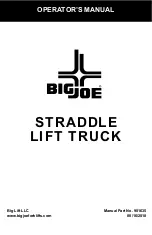
1-6
(4) Use jack stands, supporting blocks or a bench suitable for supporting
the truck:
·
Do not use square timbers as supporting blocks.
·
Use only specified jack stands, supporting blocks or platform.
·
Use jack stands, supporting blocks and a bench that have enough
strength for the purpose.
·
Test the jack stands, supporting blocks or bench before using them
and make sure you understand their weight limit.
·
Use hard timbers such as apitong or pine as supporting blocks.
Check them for cracks, deformation, or corrosion at regular
intervals, and replace them if necessary.
(5) When inserting jack stands or supporting blocks under the truck, use
caution not to get your hands or fingers pinched.
<Crane>
(1) Operation of cranes with a lifting capacity of 5 tons or more or mobile
cranes (excluding a floor type crane) must be only performed by a
qualified operator.
(2) Setting up a sling for a load of 1 ton or more must be performed by a
person qualified to do so.
(3) Basic rules of sling work:
·
Do not exceed the rated capacity of the crane. As a rough guide,
assume the capacity of the crane is 20 percent less than the rated
capacity.
·
Lift the truck from two points or more, never from a single point.
The lifting angle of the chains or cable must be less than 60 degrees
and the position of the center of gravity of the load must be low as
possible.
·
Do not exceed the specified capacity for the wire ropes.
·
Position the hook directly over the load you are going to lift.
·
Attach pads to any sharp areas on the load where the wires might
come in contact with the load.
·
Do not hook the lifting cables on a slippery area or any area from
which the hook can be easily disengaged.
·
Do not lift at an angle and do not pull horizontally.
·
Stop lifting the load when it is about 10 cm above its resting
position and check for stability and the center of gravity of the load.
·
Have a guide at a position clearly visible by the worker, and let him
give instructions for the work.
·
Make sure everyone understands the meaning of any hand signals
and the communication methods that will be used.
·
Do not ride on a load being lifted. Do not allow anyone to stand or
walk under a raised load.
·
Use a guide rope when lifting a long load.
·
Before lifting the load off the ground, reposition the main hook just
above the load’s center of gravity, to prevent the load from rolling.
Rectangular
cross section
No projecting
bolts allowed
Pads
Содержание FD35C9
Страница 2: ......
Страница 4: ...Empty page...
Страница 6: ...Empty page...
Страница 8: ......
Страница 44: ...2...
Страница 112: ...2 68 Fig 2 182 Connect the hoses 2 to the lift cylinders 1 2...
Страница 114: ...2...
Страница 208: ...3 94 Fig 3 299 Remove the tapered roller bearing cup 2 from the hub 1...
Страница 282: ...2...
Страница 290: ......
Страница 291: ......













































